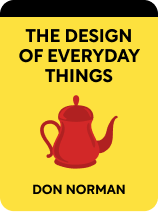

This article is an excerpt from the Shortform book guide to "The Design of Everyday Things" by Don Norman. Shortform has the world's best summaries and analyses of books you should be reading.
Like this article? Sign up for a free trial here .
What is affordance design? Why should you take affordances into account when creating a new product?
Affordance design refers to the idea of designing with an understanding that people can only interact with a product or object in a limited number of ways. There are several types of affordances to consider.
Read more about affordance design and how it works.
Affordances and Affordance Design
The term “affordance” refers to the relationship between an object and a user. Affordances are the finite number of ways in which a user can possibly interact with a given object. They answer the question, “What is this thing for?” Affordance design takes this into account.
For example, think of a chair. Chairs typically have a flat surface, which we intuitively recognize as an indicator of support, either for a person or an object. In other words, the look of a chair suggests that it is for sitting on, or possibly resting objects on.
Some affordances are obvious from the appearance of the object itself, like the flat surface of the chair. Other affordances may be less intuitive or even completely hidden. For example, if the chair were light enough (and the user strong enough), throwing across the room may be another affordance of the chair. Similarly, if the chair had a well-hidden secret compartment, hiding objects would be an affordance of the chair, regardless of whether the user discovers the drawer or not. The key is that it is a possible interaction.
Affordances can be deliberately designed—by nature, a chair is designed for sitting, a coat rack is designed to hold coats, and a stair railing is designed to prevent falls. But affordances can also arise completely by accident. The chair could also be used as a step stool, the coat rack as a child’s climbing gym, or the railing as a bookshelf. These aren’t the uses the designer had in mind, but they are equally valid affordances.
However, affordances are not merely properties of the object itself. Instead, they describe the relationship between the object and the user. This means that without a user to interact with, an object has no affordances. It also means that affordances for the same object can vary between different users. Think back to the chair example. If the user is a toddler, crawling under might be another affordance of the chair. But if the user is a large adult, crawling under is not a possible interaction between the user and the chair. The chair remains the same, but the affordance changes based on the different characteristics of the user. So how does affordance design come into play?
Signifiers
The idea of hidden affordances highlights the need for signifiers. A signifier is a signal that draws the user’s attention to an affordance they may not have intuitively discovered. In a digital context, a “click here” button or flashing icon are possible signifiers. In the example below, the “push” sign is a signifier. It contrasts with the perceived affordance of the handles (pulling), which may cause confusion. This is one example of affordance design.
Guiding Behavior With Affordance Design
Building on the lessons of the previous chapters, we’ll now explore a new way to guide behavior with design: constraints. Constraints limit the ways users can interact with an object. They create affordances, but they also guide users on which affordances to focus on. There are four main types of constraints: physical, cultural, semantic, and logical.
Physical Constraints
Physical constraints are physical qualities of an object that limit the ways it can interact with users or other objects. The shape and size of a jar lid act as physical constraints that prevent it from being attached to the wrong jar; different-sized holes on some electrical outlets constrain the way plugs can be connected; the height of a doorknob constrains the type of people who can use the door.
Physical constraints can be deliberately designed to ensure an object is used correctly, but this doesn’t always result in increased usability. Cylindrical batteries are a common example: Although the shapes of each end of the battery are slightly different, that difference only constrains the electrical circuit, not the placement of the batteries. This is why most of us have experienced accidentally inserting a battery backwards and having to pry it out without damaging the terminal.
Forcing Functions
Forcing functions are physical constraints specifically designed to prevent certain actions from occurring at the wrong times or in the wrong contexts. Three important forcing functions are interlocks, lock-ins, and lock-outs.
- Interlocks constrain the sequence of interactions with a given device, usually by blocking potentially dangerous functions until safety measures are in place. Interlocks are at play when microwaves and dryers automatically turn off when opened, or when a car won’t shift out of park until the brake is applied.
- The “dead man’s switch” function of dangerous machinery like chainsaws and riding lawn mowers is another common example of an interlock. This spring-loaded switch requires continuous pressure: If it is released, the device immediately shuts off, ensuring that dangerous equipment will not run wild if the user becomes incapacitated.
- Lock-ins constrain users to a particular activity, area, or pattern. Physical barriers like jail cells are lock-ins, as are digital programs that make it difficult for users to quit out of an application accidentally. Lock-ins can also be more abstract: When tech companies create products that are only compatible with products of the same brand, they are locking the user into a continuous pattern of brand loyalty.
- Lock-outs prevent users from entering dangerous areas or performing dangerous functions. Like the names suggest, lock-ins are designed to keep people in, while lock-outs are designed to keep people out. Childproof caps on bottles of medicine or dangerous chemicals are common lock-outs. Home security systems lock unwanted people out of private areas.
Cultural Constraints
Cultural constraints are the “rules” of society that help us understand how to interact with our environment. These rules operate through schemas (also called “scripts” or “frames”): mental models that help us interpret our environment. Schemas help us navigate new situations based on our knowledge of similar environments.
Imagine you wander into an unfamiliar building in a new city. You see tables all around, some of them with groups of people sitting and eating. Other people are carrying trays of food to and from the tables. These people are wearing aprons and name tags. All of these clues combine to activate the “restaurant” schema in your head—now you know not only what type of building you’re in, but how to behave appropriately in the situation.
Conventions
Schemas help us interpret our environment, but conventions and standards tell us how to interact with it. In the restaurant example, a schema helped you interpret the environment by combining the information from your senses and matching that to an existing mental model of “restaurant.” Now that you understand the environment, you need to choose how to act appropriately within it. For that, you’re more likely to rely on conventions. Conventions are culturally-dependent agreements about how things are done. They are social rules that constrain our behavior.
- (Shortform note: The distinction between schemas and conventions can be confusing. Generally speaking, schemas describe how we think, while conventions describe how we act. But understanding this subtle difference isn’t crucial for the rest of the book, so don’t worry too much if it seems a bit muddy.)
Conventions also act as cultural constraints that affect how we interpret signifiers and perceived affordances. Think of a typical doorknob. The knob itself is the same shape and size as a cupped hand, so “grasping” is an intuitive perceived affordance which is understood from the affordance design. But nothing about the knob itself tells us it should be twisted, or that its purpose is to open and close doors. Those functions are cultural conventions that are learned from other people in our environment. To illustrate this, think of a doorknob mounted on a regular wall. You probably wouldn’t attempt to twist it, or expect it to open or close the wall, because the knowledge that “knobs open doors, not walls” is a universal cultural convention.

———End of Preview———
Like what you just read? Read the rest of the world's best book summary and analysis of Don Norman's "The Design of Everyday Things" at Shortform .
Here's what you'll find in our full The Design of Everyday Things summary :
- How psychology plays a part in the design of objects you encounter daily
- Why pushing a door that was meant to be pulled isn't your fault
- How bad design leads to more human errors






